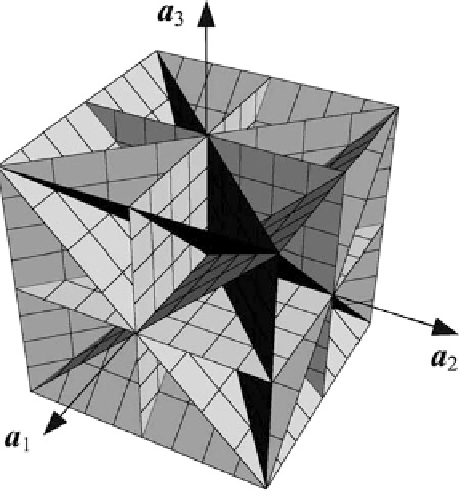Biomedical Engineering Reference
In-Depth Information
Fig. 4.12
An illustration
of the nine planes of
symmetry characterizing
cubic symmetry. The positive
octant at the front of the
perspective is bounded by
three of the symmetry planes
with normals
a
1
,
a
2
, and
a
3
and contains traces of the
six other planes of symmetry.
From Rovati and
Taliercio (
2003
)
same as the 6 constant tetragonal and trigonal symmetries, respectively. This
selection of the coordinate system is always possible without restricting the gener-
ality of the matrix representations (Cowin
1995
; Fedorov
1968
).
This classification of the types of linear elastic material symmetries by the number
and orientation of the normals to the planes of material symmetry is fully equivalent
to the crystallographic method using group theory (Chadwick et al.
2001
).
Problems
4.5.1. Construct diagrams of the number and orientation of the normals to the
planes of reflective symmetry for six of the eight material symmetries
(diagrams for the other two, tetragonal and cubic, and prose descriptions
for all the symmetries are given in the text); the triclinic, monoclinic,
orthotropic, hexagonal,
transverse
isotropic,
and isotropic material
symmetries.
4.5.2. Construct a diagram for the set of normals to the planes of reflective
symmetry given in Problem 4.4.6, with the addition of the normal
e
3
so
that the set now consists of seven vectors:
k
,
p
,
m
,
n
,
e
1
,
e
2
, and
e
3
.
4.5.3. From the images of simplified crystal models shown in Figs.
4.13a, b
,
identify the appropriate material symmetry for the object in each figure,
set up the convenient coordinate system for the object, and list the vectors of
the normals to the planes of symmetry characterizing each particular
symmetry.

Search WWH ::

Custom Search